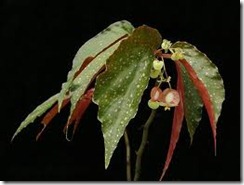Cane begonias are one of the eight groups of begonias horticulturally classified by the American Begonia Society. They are tropical perennials with stiff but fleshy stems with an upright habit. Their leaves are often shaped like angel wings and may have attractive white spots or colored edges. Flowers from white to pink or red also appear, making them desirable houseplants or outdoor plants in frost-free regions. Begonias do not excel in overly wet or soggy soils, and very bright indirect light to some direct sunlight increases flowering while encouraging leaf development and branching. Too little light creates leggy, weak plants.
- Difficulty:
- Easy
Instructions
things you’ll need:
- Balanced formula of a water soluble fertilizer
- Watering can
- Granular fertilizer
- Compost
- Fertilize cane begonias only when they are actively growing across the calendar year. A general rule is to fertilize them from spring to fall, not in winter. According to Mark Tebbitt, author of "Begonias," purchase a water soluble fertilizer product with nutrient ratio 20-10-20.
- Mix the fertilizer per the product directions as Tebbitt notes over-fertilization can burn begonia roots. Do not apply fertilizer to newly potted begonias until after one month’s acclimation time. Also do not fertilize sick plants since they have heightened risk of root damage from fertilization.
- Sprinkle some granules of a well-balanced fertilizer (slow release) atop the soil around the base of the cane begonia. Follow product label directions for amount to use for the size container or size of the plant. Although not necessary if a water-soluble fertilizer regimen is used, Tebbitt states that soil-less potting mixes such as those comprised entirely of peat usually require more fertilization than outdoor garden soils. The slow-release granules provide trace nutrition year round during casual watering when the liquid fertilizer leaches out of the container.
Tips & Warnings
-
If you grow cane begonias outdoors in a tropical climate, the use of compost as a soil top dressing and slow release fertilizer granules is better than solely relying on liquid fertilizer feedings. Sandy soils especially leach out nutrients so organic matter and fertilizer granules last much longer and provide better results for the begonias.
-
Chicago Botanic Garden notes that over-fertilizing begonias also can lead to excessive stem (cane) growth, so it recommends liquid fertilizing no more than once a month from April to October.


Deprecated: strpos(): Passing null to parameter #1 ($haystack) of type string is deprecated in /home/agriviek8Qv/agriviet.net/public_html/wp-includes/comment-template.php on line 2522